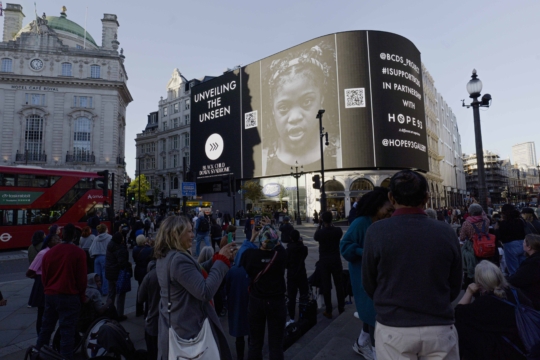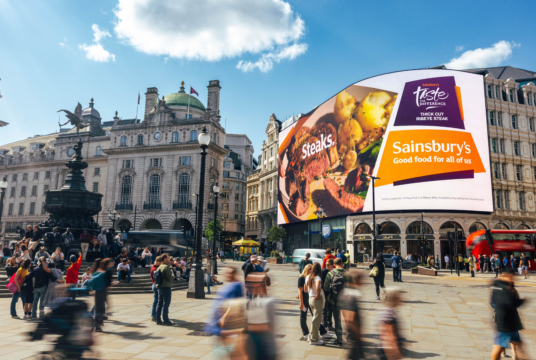December is the month of socialising and celebrations; therefore, it seems obvious that – and according to Nielsen data – it’s also the time for drink brands to invest more in media. Therefore, carrying on with our category focuses, we’ve conducted research through our @TheLocal consumer panel, YouGov, and more to provide evidence and inspiration for how brands could use OOH to create more awareness and results during the festive season.
There are interesting category nuances that are key to understanding how to drive success this season. Our research showed that the drinks industry is split into four main subcategories to focus on in December: alcohol, alcohol-free, soft drinks, and hot drinks.
What is the opportunity for alcohol brands?
53% of @TheLocal respondents plan to socialise and share drinks with friends and colleagues at festive events, indicating significant demand for social drinking in December[1]. 92% of adults agree that food and drink are a crucial part of Christmas, emphasising the importance of drinks in festive celebrations. [2]This is further proven by 58% of our @TheLocal respondents saying that they consume alcohol more frequently during the festive season[3].
Additionally, despite the data and information about the cost-of-living crisis, 46% of all adults are planning to treat themselves to premium alcohol products/brands this Christmas, indicating that they are willing to prioritise paying for quality drinks. [4]There’s also a significant opportunity for craft beer brands during the festive period, as during Christmas 2022 craft beer reached a record 7.3% of total beer sales[5]. With many shoppers looking for premium options over this period, craft beer offers retailers an excellent opportunity to drive sales into a more profitable category.
Christmas is also a time of gift giving, 48% of adults in the UK are likely to buy alcoholic drinks as a gift for someone[6]. This means that brands have different types of messaging to think about, influencing what a person will drink themselves and what they will buy as a gift.
Classic wine and beer are still popular, with spirits seen as a treat: 40% @TheLocal respondents said wine is their alcoholic drink of choice this Christmas, and 27% chose beer. [7]However, spirits are the most popular alcoholic drink for gifting[8]. This shows that people might be willing to go more premium when it comes to buying for others and stick to the classics when it comes to themselves.
The opportunity for alcohol free brands
Over the past year, Waitrose has seen a significant 20% increase in low alcohol- and alcohol-free drink sales, with alcohol free beer leading the trend. [9]This surge prompted Waitrose to expand its dedicated areas for low and alcohol-free drinks by 60%, showcasing the escalating demand for alcohol free options.
47% of UK adults seamlessly switch between alcoholic and low/no alcohol drinks on the same occasions[10]. This shift reflects a growing inclination towards moderation, providing an increasing market of alcohol-free brands. This market is expected to grow even further as research by Food Navigator Europe anticipates a one-third increase in low/no alcohol consumption by 2026[11]. This projection underscores the expanding market potential for alcohol free beverages, aligning with changing consumer preferences.
In July 2023, The BBC spoke to people who have stopped drinking alcohol and claim to love their sober lifestyles, and a recent NHS study concluded that 1 in 3 people under 25 have not drunk alcohol for at least a year[12]. All this is steering this demographic towards low-alcohol and non-alcoholic beverages, creating a prime opportunity for alcohol free brands to cater to these preferences.
The younger generation is now becoming more openly confident with the decision to cut back on alcohol, and Lucky Saint’s initiative of opening a pub selling predominately alcohol-free beer, is a testament to this evolving trend. However, low- and no-alcohol drinks currently still lag behind soft drinks as an alcohol substitute, making it imperative for brands to prove that their products offer an exciting and special drinking experience and justify a higher price point.[13]
The opportunity for soft drink brands
Gen Z are 16% more likely to choose soft drinks as their drink of choice this Christmas and millennials are 20% more likely[14]. This demographic trend aligns with the fact that younger individuals are more likely to abstain from alcohol, making soft drinks their beverage of choice during social gatherings. Furthermore, nearly 80% of people choose soft drinks in addition to alcohol in formal or casual dining settings[15]. Considering the many social events and gatherings in December, the demand for soft drinks remains high, making it a relevant and sought-after category. The rise in confidence among individuals choosing to be alcohol-free further amplifies the demand for soft drinks. This cultural shift underscores the importance of soft drink brands capitalising on this trend through targeted December advertising campaigns.
The opportunity for hot drink brands
According to our @TheLocal survey respondents, hot chocolate and coffee are Christmas favourites[16]. There’s a year-round demand for coffee as remarkably, 86% of UK households are avid coffee consumers, and 61% who seek coffee shop quality beverages at home are willing to pay a premium. [17]
At-home coffee drinkers, inspired by café trends, opt for specialty products, creating a market shift. This transition is evident in the growth in the micro-ground and roast segment, indicating an inclination towards recreating beloved café experiences at home. Consumers are making cost-effective switches, replacing costly café visits with home versions. [18]This creates a valuable opportunity in the market that retailers should capitalise on, as consumers turn to trusted and familiar brands that they know deliver on taste and quality.
Moreover, instant drinking chocolate has become a household essential, experiencing significant YoY growth, especially among Gen Z (62% more likely) and Millennials (51% more likely) during Christmas. [19]Notably, Cadbury and Galaxy Hot Chocolate lead this trend with up to 10% YoY growth, confirming the beverage’s popularity. [20]This surge in hot drink interest, especially during December, presents a worthwhile advertising opportunity for brands, given the evident market shift and consumer preferences, particularly with quality home-bought products.
Why OOH?
Christmas shoppers predominantly spend 63% in-store and only 37% online, making physical outdoor presence vital[21]. For those purchases that are still happening online, OOH significantly influences online purchases, with almost 60% of mobile spending occurring when people are out and about.
A significant portion of adults (56%) will be Christmas shopping on the high street, and 40% will be in shopping malls, emphasising the need for OOH advertising to capture this audience. Contrary to the online shopping trend, 49% of 18-34s plan to shop on the high street, making OOH an effective way to engage this demographic[22]. Additionally, 18-34s are 64% more likely to encourage others to see 3D ads, indicating the effectiveness of innovative OOH technologies like DeepScreen®.[23]
Ocean offers a national presence and exclusive technologies through Ocean Studio and Ocean Labs, providing extensive brand exposure and enabling even smaller sub-brands to gain recognition and stand out, particularly through experiential outdoor activations and sampling new products. To learn more, click here or get in touch.
To conclude
- There’s a clear significance for various drink categories during the festive season, with consumers willing to pay premium prices.
- More social events show an overall increase in alcohol intake.
- Christmas also presents an opportunity for gift-giving, with spirits being the most popular alcoholic gift.
- A high percentage of Gen Z and millennials reveal hot chocolate to be their festive drink of choice.
- There is a growing confidence, especially among younger generations, in choosing non-alcoholic options, including alcohol-free brands and soft drinks.
- 40% of shoppers see OOH as the last window of influence[24], and as most adults’ plan to do their Christmas shopping outdoors, it serves as a vital form of media.
- For emerging brands, especially in the non-alcoholic sector, OOH presents a strategic opportunity to disrupt the market and establish a strong presence among consumers.
[1] @TheLocal, October 2023 Survey
[2] Kinetic: Alfresco Life, August 2023
[3] @TheLocal, October 2023 Survey
[4] Kinetic: Alfresco Life, August 2023
[5] Drinks Retailing, October 2023
[6] Kinetic: Alfresco Life August 2023
[7] @TheLocal, October 2023 Survey
[8] Mintel: The UK Food and Drink Gifting Market Report 2022
[9] John Lewis Partnership: Waitrose, August 2023
[10] The Kantar Shopper Panel, July 2023
[11] Food Navigator Europe January 2023
[12] BBC, July 2023
[13] Mintel: UK Attitudes towards Low and No-Alcohol Drinks Market Report 2023
[14] YouGov Insights 2023 “which, if any, of the following drinks do you prefer to drink at Christmas.”
[15] CGA by NIQ Soft Drinks Report May 2023
[16] @TheLocal, October 2023 Survey
[17] Talking Retail, February 2023
[18] Talking Retail, February 2023
[19] YouGov Insights 2023 “which, if any, of the following drinks do you prefer to drink at Christmas.”
[20] Talking Retail, February 2023
[21] Kinetic Alfresco Life, August 2023
[22] Kinetic Alfresco Life, August 2023
[23] Deepscreen research, 2022
[24] 2023 Outsmart Out of Home









